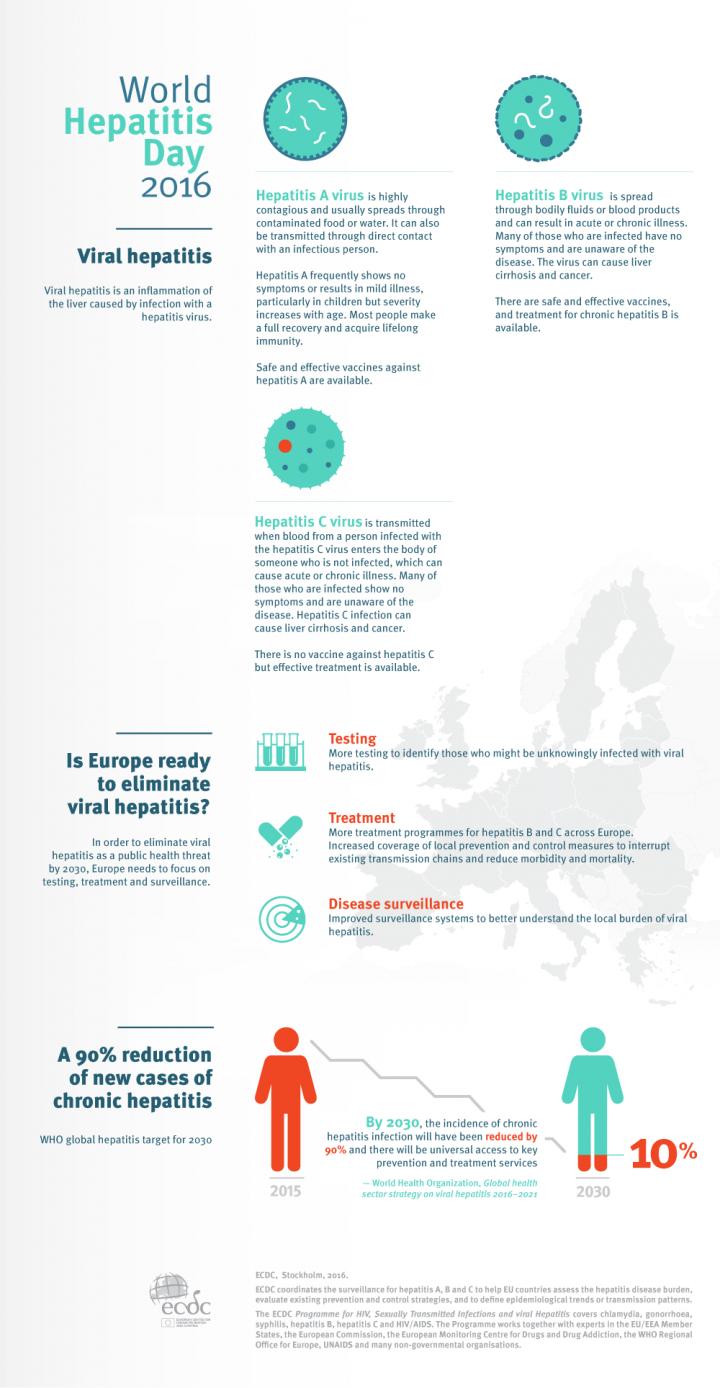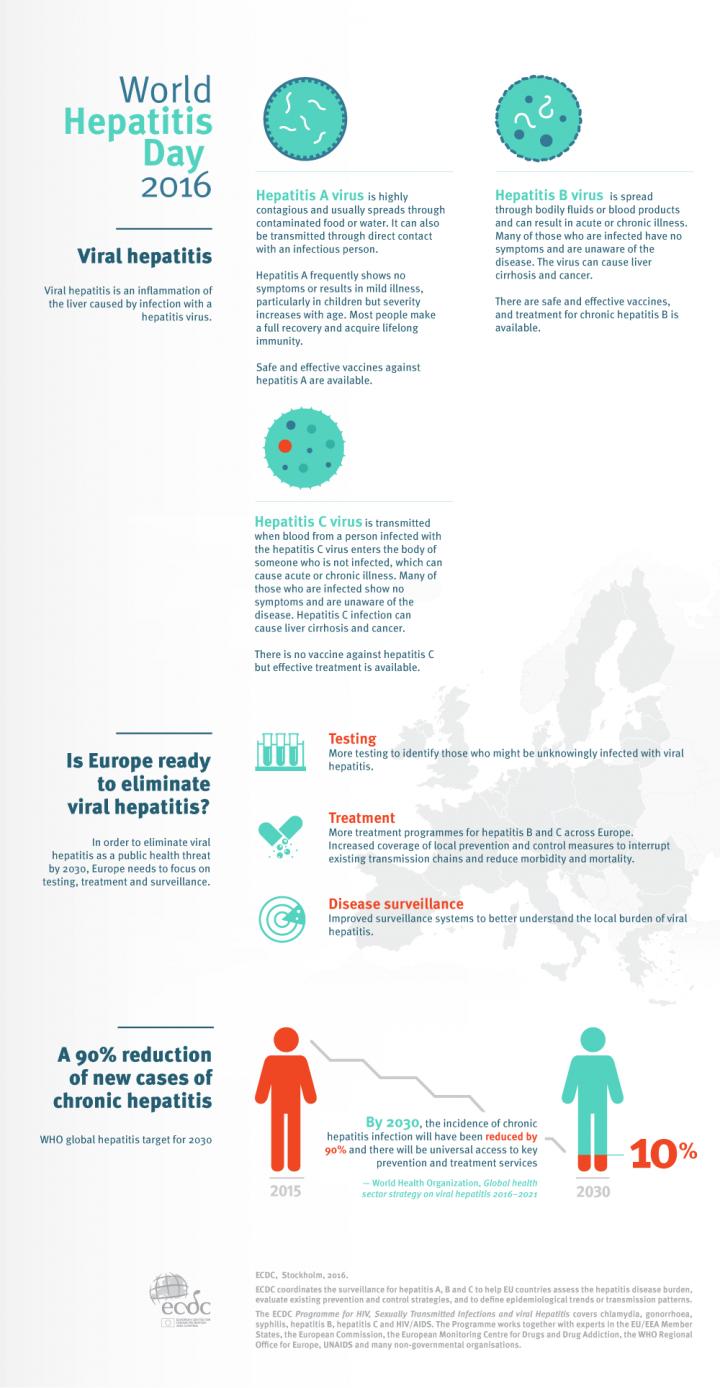
The goal for 2030: a world free of hepatitis. Currently, Europe records around 57 000 newly diagnosed acute and chronic cases of hepatitis B and C each year. On top of that, an estimated 10 million Europeans are believed to suffer from chronic hepatitis B and C infection – and most of them do not even know about it as the infection often shows no symptoms. In order to eliminate hepatitis as a public health issue, as set out in a new global strategy, Europe needs to scale-up coverage of testing, prevention interventions and treatment services.
The recently launched global strategy on viral hepatitis aims at eliminating hepatitis B (HBV) and C (HCV) as public health threats by 2030. Among the goals: a 90% drop in the number of chronically infected people and reduction of the mortality rate by 65% as untreated chronic viral hepatitis can cause irreversible liver damage leading to cirrhosis or cancer.
"To eliminate viral hepatitis in Europe, we need to work together to boost testing services, scale up treatment programmes and increase the coverage of prevention interventions to prevent infections in the first place", says ECDC Acting Director Andrea Ammon on the occasion of World Hepatitis Day. "At the same time, our surveillance systems need to be improved because the current data sources in most countries of the European Union and European Economic Area are insufficient to adequately assess the actual local burden of viral hepatitis."
ECDC is working closely with the Member States to improve local surveillance systems and develop alternative epidemiological methods to complement routine surveillance for example with seroprevalence and sentinel surveys.
"Our data show on-going transmission of hepatitis in Europe. If we want to interrupt this chain and prevent further infections, we need to strengthen local prevention and control practices", Ammon explains. "There are now highly effective drugs available for people infected with hepatitis B and C. But we also need to test more for hepatitis to make sure that we are able to identify and diagnose all those who might be unknowingly infected."
Vytenis Andriukaitis, European Commissioner for Health and Food Safety, said: "Viral hepatitis continues to pose a serious health challenge in the European Union. Further efforts are needed to prevent and combat this disease, which is sometimes called the 'silent killer' as symptoms often do not appear until it is too late. Hepatitis is also 'silent' in the way that it affects the most vulnerable groups of our society. We need to increase the volume on this preventable disease, and the Commission is playing its part in supporting national efforts so that we collectively eliminate hepatitis in Europe. For example, the Commission is investing over 1 million euros in a new project to support early diagnosis of viral hepatitis."
HBV and HCV trends across Europe
New data for hepatitis B and hepatitis C infection show a greater disease burden for hepatitis C compared with hepatitis B across Europe. Numbers and notification rates for HCV are nearly twice as high as those of hepatitis B: between 2006 and 2014, around 161 000 newly diagnosed cases of hepatitis B and more than 276 000 hepatitis C infections were recorded. In 2014 alone, 22 442 cases of hepatitis B virus infection were reported from 30 EU/EEA Member States and 28 EU/ EEA Member States recorded 35 321 new cases of hepatitis C.
While the reported rate of acute HBV cases almost halved (54%) since 2006 – most likely a result of national vaccination programmes – rates of chronic cases have constantly gone up over time from 5.7 per 100 000 population in 2006 to 9.8 in 2014. This increase is probably due to changes in reporting methods as well as increases in local testing practices.
Between 2006 and 2014, the overall number of HCV cases diagnosed and reported across all EU/EEA Member States increased by 28.7%, with most of this increase observed since 2010.
In the EU/EEA as a whole, a new ECDC study estimates that migrants account for around 25% of chronic hepatitis B, and 14% of chronic hepatitis C cases in the EU/EEA. But despite a high burden of chronic viral hepatitis infections among migrants, the risk of onward transmission of infection is likely to be low. The aim of this study was to estimate the chronic viral hepatitis burden in terms of infected cases among first-generation migrants in EU/EEA countries based on best available data sources and to identify those migrant groups with the largest number of cases who would benefit most from targeted screening programmes and early linkage to care.
Four decades of data: hepatitis A in Europe
In order to assess Hepatitis A virus endemicity and overall population susceptibility in the EU/EEA, ECDC published a systematic review [add link] on Hepatitis A virus (HAV) seroprevalence and Hepatitis A incidence in EU/EEA countries from 1975 to 2014. It demonstrates that although while HAV circulation has been decreasing steadily over the past four decades in the region as a whole, a progressively growing part of the EU/EEA population has become susceptible to HAV infection, which leads to a need to reconsider the overall prevention strategy.
###
Media Contact
ECDC Press Office
[email protected]
46-858-601-678
@ECDC_EU
http://ecdc.europa.eu





